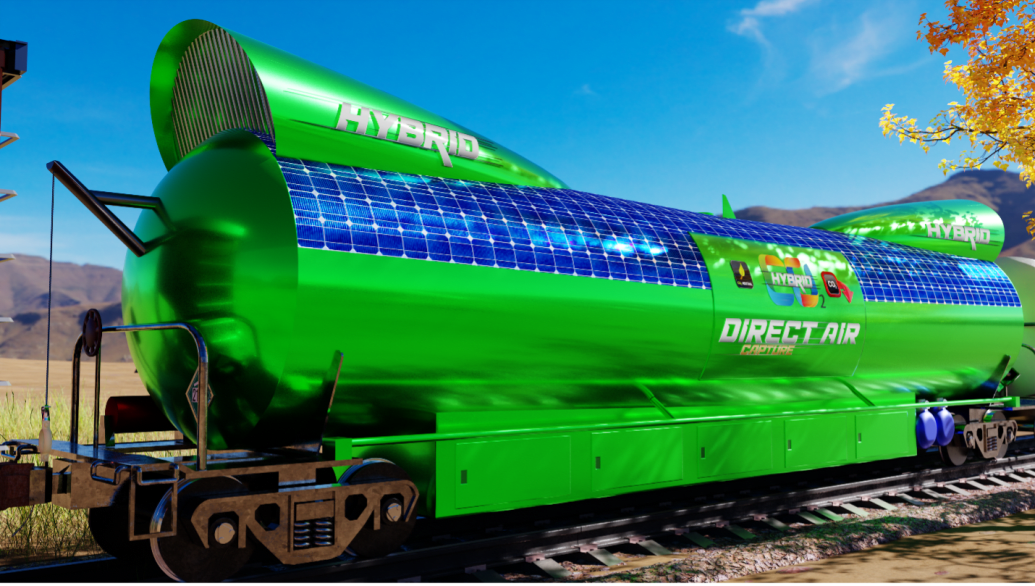Modified rail cars clean air of CO2 and help mitigate climate change
New research shows rail systems around the world could be harnessed to help mitigate climate change and clean our air of CO2.

[July 21, 2022: Amy Huxtable, University of Sheffield]
CO2Rail Car with zero-carbon, regenerative braking powered Direct Air Carbon Capture and air intakes that extend up into the slipstream of the moving train. (CREDIT: CO2Rail Company)
Modified rail cars clean air of CO2 and help mitigate climate change
New research shows rail systems around the world could be harnessed to help mitigate climate change and clean our air of CO2
Researchers from the University of Sheffield are working with US-based CO2Rail Company to design Direct Air Capture equipment which can be used within special rail cars placed with already running trains
On average, each complete train braking manoeuvre generates enough energy to power 20 homes for an entire day - until now this enormous amount of sustainable energy has been wasted
If the energy of every stop or deceleration for every train in the world could be captured it would harness 105 times more energy than the Hoover Dam produces in the same time period
Rail systems around the world could help mitigate climate change and clean the air of CO2 by capturing the sustainable energy generated when trains break and decelerate.
US-based startup, CO2Rail Company have been working with a world-renowned team of researchers, including engineers from the University of Sheffield, to design Direct Air Capture (DAC) technology that removes carbon dioxide from the air, which can be used within special rail cars placed with already running trains in regular service.
The DAC rail cars work by using large intakes of air that extend up into the slipstream of the moving train to move ambient air into the large cylindrical CO2 collection chamber and eliminate the need for energy-intensive fan systems that are necessary with stationary DAC operations.
Related Stories
The air then moves through a chemical process that separates the CO2 from the air and the carbon dioxide free air then travels out of the back or underside of the car and returns to the atmosphere.
After a sufficient amount has been captured, the chamber is closed and the harvested CO2 is collected, concentrated, and stored in a liquid reservoir until it can be emptied from the train at a crew change or fuelling stop into normal CO2 rail tank cars. It is then transported into the circular carbon economy as value-added feedstock for CO2 utilisation, or to nearby geological landfill sites.
Each of these processes are powered exclusively by on-board generated, sustainable energy sources that require no external energy input or off-duty charging cycles.
CO2Rail cars harvest many magnitudes more CO₂ than is indirectly emitted by the locomotives in fuel proximate to their operation in additional train loading, aerodynamic drag, and rolling resistance. (CREDIT: CO2Rail Company)
When a train pumps the brakes, its energy braking system converts the train’s forward momentum into electrical energy in much the same way as a regenerative electric vehicle. Currently, this energy is dissipated on trains in the form of heat and discharged out of the top of the locomotive during every braking manoeuvre.
Professor Peter Styring, Director of the UK Centre for Carbon Dioxide Utilization at the University of Sheffield and co-author of the research, said: “The direct capture of carbon dioxide from the environment is increasingly becoming an urgent necessity to mitigate the worst effects of climate change.
Certain configurations with multiple intakes can remove over 15 Tonnes of CO2 per day for geological sequestration and have no fixed, land footprint. Each complete braking maneuver produces enough energy from regenerative braking to remove over 1.5 Tonnes of CO2. (CREDIT: CO2Rail Company)
“Currently the enormous amount of sustainable energy created when a train brakes or decelerates is simply lost. This innovative technology will not only use the sustainable energy created by the braking manoeuvre to harvest significant quantities of CO2, but it will also take advantage of many synergies that integration within the global rail network would provide.
“The technology will harvest meaningful quantities of CO2 at far lower costs and has the potential to reach annual productivity of 0.45 gigatons by 2030, 2.9 gigatons by 2050, and 7.8 gigatons by 2075 with each car having an annual capacity of 3,000 tonnes of CO2 in the near term.”
Unlike stationary DAC operations, which require large areas of land to build equipment and to construct renewable sources of energy to power them, CO2Rail would be transient and would generally be unseen by the public. The potential impact of this technology was recently energised when European transport organisations announced earlier this month that they are committed to tripling high-speed rail use by 2050 to curb CO2-heavy air travel.
Eric Bachman of CO2Rail Company, said: “On average, each complete braking manoeuvre generates enough energy to power 20 average homes for an entire day so it is not a trivial amount of energy.
“Multiply this by every stop or deceleration for nearly every train in the world and you have about 105 times more energy than the Hoover Dam produces within that same period, and that was a hydro-electric construction project that took six years and cost $760 million in today’s dollars.”
He added: “Imagine stepping onto a train each morning, seeing the CO2Rail cars attached, and knowing that your commute to work each day is actually helping to mitigate climate change.
“It will work the same with freight, if there is a choice between rail and another mode of transportation, I think this technology will sway many shippers.”
The team, which includes researchers from the University of Sheffield, University of Toronto, MIT, Princeton, business, and industry, found each direct air capture car can harvest about 6,000 metric tons of carbon dioxide from the air per year and more as the technology develops. Moreover, since trains are capable of hosting multiple CO2Rail cars, each train will harvest a corresponding multiple of CO2 tonnage.
With its sustainable power requirements exclusively supplied by train-generated sources that are without incremental cost, savings of 30 – 40 per cent per tonne of harvested CO2 can be realised from energy inputs alone.
This, along with other significant savings such as land, brings projected cost at scale down to less than $50 per tonne and makes the technology not only commercially viable but commercially attractive.
Professor Geoffrey Ozin from the University of Toronto and co-author of the study, said: “At these price points and with its tremendous capabilities, CO2Rail is likely to soon become the first megaton-scale, first gigaton-scale, and overall largest provider of direct air capture deployments in the world.
“Carbon-neutral in regular transportation and then significantly carbon-negative with ambient air DAC operations. A win-win in every respect and a ‘save humanity’ technology.”
The team is also working on a similar system that can remove the CO2 emissions from the exhaust of diesel-powered locomotives as are universally common in North America and other parts of the world. With the growth of sustainably-sourced rail electrification systems, this point-source capability on diesel lines would make rail the world’s first carbon-neutral mode of large-scale transportation.
The research entitled: “Rail-Based Direct Air Carbon Capture” is published in the Future Energy section of the journal Joule.
For more environmental news stories check out our Green Impact section at The Brighter Side of News.
Note: Materials provided above by University of Sheffield. Content may be edited for style and length.
Like these kind of feel good stories? Get the Brighter Side of News' newsletter.
Joseph Shavit
Head Science News Writer | Communicating Innovation & Discovery
Based in Los Angeles, Joseph Shavit is an accomplished science journalist, head science news writer and co-founder at The Brighter Side of News, where he translates cutting-edge discoveries into compelling stories for a broad audience. With a strong background spanning science, business, product management, media leadership, and entrepreneurship, Joseph brings a unique perspective to science communication. His expertise allows him to uncover the intersection of technological advancements and market potential, shedding light on how groundbreaking research evolves into transformative products and industries.



